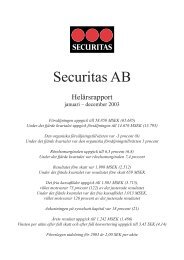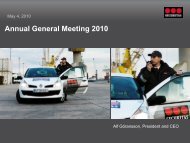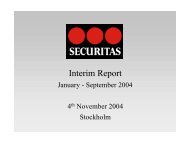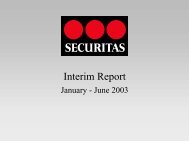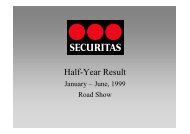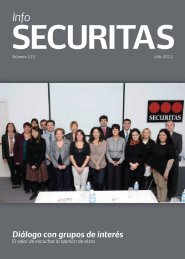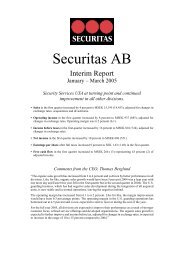Annual Report 2008 - Securitas
Annual Report 2008 - Securitas
Annual Report 2008 - Securitas
Create successful ePaper yourself
Turn your PDF publications into a flip-book with our unique Google optimized e-Paper software.
72<br />
<strong>Annual</strong> report<br />
Notes and comments to the consolidated financial statements<br />
Provisions are allocated for estimated taxes on dividends from subsidiaries<br />
to the Parent company in the following year.<br />
Deferred income tax is provided on temporary differences arising on investments<br />
in subsidiaries and associates, except where the timing of the reversal<br />
of the temporary difference is controlled by the Group and it is probable<br />
that the temporary difference will not be reversed in the foreseeable<br />
future.<br />
Non-current assets held for sale and discontinued<br />
operations (IFRS 5)<br />
The Group applies IFrS 5 Non-current assets held for sale and discontinued<br />
operations, which sets out requirements for the classification, measurement<br />
and presentation of non-current assets held for sale and discontinued operations.<br />
According to IFRS 5 a non-current asset classified as held for sale or disposal<br />
group shall be measured at the lower of its carrying amount and fair<br />
value less cost to sell, if the carrying amount will be recovered through a<br />
sales transaction rather than through its continuous use in the operations.<br />
Measurement is carried out in two steps. First, all assets and liabilities are<br />
measured in accordance with the relevant standard. For disposal groups a<br />
second step also involves a re-measurement to the lower of the carrying<br />
amount and the fair value less cost to sell. A re-measurement should be<br />
carried out at each balance sheet date subsequent to the initial recognition.<br />
No depreciation or amortization should be recognized for these assets from<br />
the date of reclassification up until the disposal has been completed. As of<br />
July 1, 2007 the Group recognized certain assets and liabilities as belonging<br />
to a so-called disposal group. The disposal group related to the sale of the<br />
operations of Loomis cash Management Ltd in the United Kingdom and<br />
was de-recognized from the balance sheet upon completion of the sale of<br />
the non-current assets and operations on November 24, 2007. The initial<br />
recognition of the disposal group was in the interim report for the third<br />
quarter 2007 and consequently no subsequent re-measurement took place<br />
before the completion of the sale on November 24, 2007. The result from<br />
the sale of the non-current assets and operations of Loomis cash Management<br />
Ltd is included in Net income for the year, discontinued operations.<br />
A discontinued operation is a component of a Group that represents a<br />
major line of business or geographical area of operations. The net income<br />
(after tax) relating to discontinued operations is included on a separate line,<br />
net income for the year, discontinued operations. Notes relating to the<br />
statement of income have consequently been adjusted to exclude discontinued<br />
operations.<br />
The extraordinary General Meetings in <strong>Securitas</strong> held on December 3,<br />
<strong>2008</strong> and September 25, 2006, resolved in accordance with the Board of<br />
Directors’ proposal on a dividend to the effect that all shares in the whollyowned<br />
subsidiaries Loomis AB, <strong>Securitas</strong> Direct AB and Niscayah Group AB<br />
(former <strong>Securitas</strong> Systems AB) would be distributed to the shareholders.<br />
The dividend date was December 9, <strong>2008</strong> for Loomis AB and September<br />
29, 2006 for <strong>Securitas</strong> Direct AB and Niscayah Group AB. From these dates<br />
Loomis AB, <strong>Securitas</strong> Direct AB and Niscayah Group AB are no longer part<br />
of the <strong>Securitas</strong> Group. These operations, which in the <strong>Securitas</strong> Group previously<br />
comprised the three primary segments Loomis, Direct and <strong>Securitas</strong><br />
Systems, consequently qualify as discontinued operations according to<br />
IFrS 5 and are treated according to this standard. Further information on<br />
the application of IFrS 5 regarding Loomis, Direct and <strong>Securitas</strong> Systems<br />
is provided in Note 39.<br />
Statement of cash flow (IAS 7)<br />
The statement of cash flow has been prepared in accordance with the<br />
indirect method. Liquid funds include cash and bank deposits and Shortterm<br />
investments with a maximum duration of 90 days at the time of initial<br />
recognition.<br />
<strong>Securitas</strong> <strong>Annual</strong> report <strong>2008</strong><br />
Goodwill and other acquisition related intangible assets<br />
(IFRS 3, IAS 36 and IAS 38)<br />
Goodwill represents the excess of the cost of an acquisition over the fair<br />
value of the Group’s share of the identifiable net assets of the acquired subsidiary/operations<br />
at the date of acquisition. Goodwill is tested annually for<br />
impairment and carried at cost less accumulated impairment losses. Gains<br />
and losses on the disposal of an entity include the carrying amount of goodwill<br />
relating to the entity or operations sold.<br />
Other acquisition related intangible assets arising from acquisitions can<br />
include various types of intangible assets such as marketing-related, customer-related,<br />
contract-related and technology-based. Other acquisition<br />
related intangible assets have a definite useful life. These assets are recognized<br />
at fair value on the date of acquisition and subsequently carried at cost<br />
less accumulated amortization and any accumulated impairment losses.<br />
Amortization is calculated using the linear method to allocate the cost of<br />
assets over their estimated useful lives. <strong>Securitas</strong>’ acquisition related intangible<br />
assets mainly relate to customer contract portfolios and the related<br />
customer relationships. The valuation of the customer contract portfolios<br />
and the related customer relationships is based on the Multiple Excess<br />
Earnings Method (MEEM) which is a valuation model based on discounted<br />
cash flows. The valuation is based on the churn rates and profitability of the<br />
acquired portfolio at the time of the acquisition. In the model a specific charge<br />
– a contributory asset charge – is applied as a cost or return requirement for<br />
the assets supporting the intangible asset. Cash flows are discounted using<br />
the weighted Average cost of capital (wAcc) adjusted for local interest<br />
rate levels in the countries of acquisition. The useful life of customer contract<br />
portfolios and the related customer relationships are based on the churn<br />
rate of the acquired portfolio and are normally between 3 and 20 years corresponding<br />
to a yearly amortization of between 5 percent and 33.3 percent.<br />
A deferred tax liability is calculated at the local tax rate on the difference<br />
between the book value and tax value of the intangible asset. The deferred<br />
tax liability is reversed over the same period as the intangible asset is amortized,<br />
which means that it neutralizes the impact of the amortization of the<br />
intangible asset on the full tax rate percentage on the income after tax. The<br />
initial recognition of this deferred tax liability increases the amount of goodwill.<br />
Goodwill and other acquisition related intangible assets are allocated to<br />
cash-generating units (cGU) at a level that is consistent with the level at<br />
which <strong>Securitas</strong> monitors performance, that is per country in a business<br />
segment. This allocation is also the basis for the yearly impairment testing.<br />
The amortization of acquisition related intangible assets is shown on the<br />
line Amortization and impairment of acquisition related intangible assets in<br />
the statement of income.<br />
Acquisition related restructuring costs<br />
Acquisition related restructuring cost are costs relating to the restructuring<br />
and/or integration of acquired operations into the Group. restructuring costs<br />
are costs that are recognized based on the specific criteria for restructuring<br />
provisions in IAS 37 (see further under Provisions below). restructuring<br />
costs can cover several activities that are necessary to prepare acquired<br />
operations for integration into the Group such as redundancy payments,<br />
provisions for rented premises that will not be utilized or sublet below cost<br />
or other non-cancellable leasing contracts that will not be utilized. Integration<br />
costs normally cover activities that do not qualify to be recognized as provisions.<br />
Such activities could be re-branding (changing logotypes on buildings,<br />
vehicles, uniforms etc) but could also cover personnel costs for example<br />
training, recruitment, relocation and travel, certain customer related costs<br />
and other incremental costs to transform the acquired operation into the<br />
acquirers format. classifying expenses as costs relating to integration of<br />
acquired operations must also fulfil the criteria below:<br />
• The cost would not have been incurred had the acquisition not take place.<br />
• The cost relate to a project identified and controlled by management as<br />
part of a integration programme set up at the time of acquisition or as a<br />
direct consequence of an immediate post-acquisition review.




